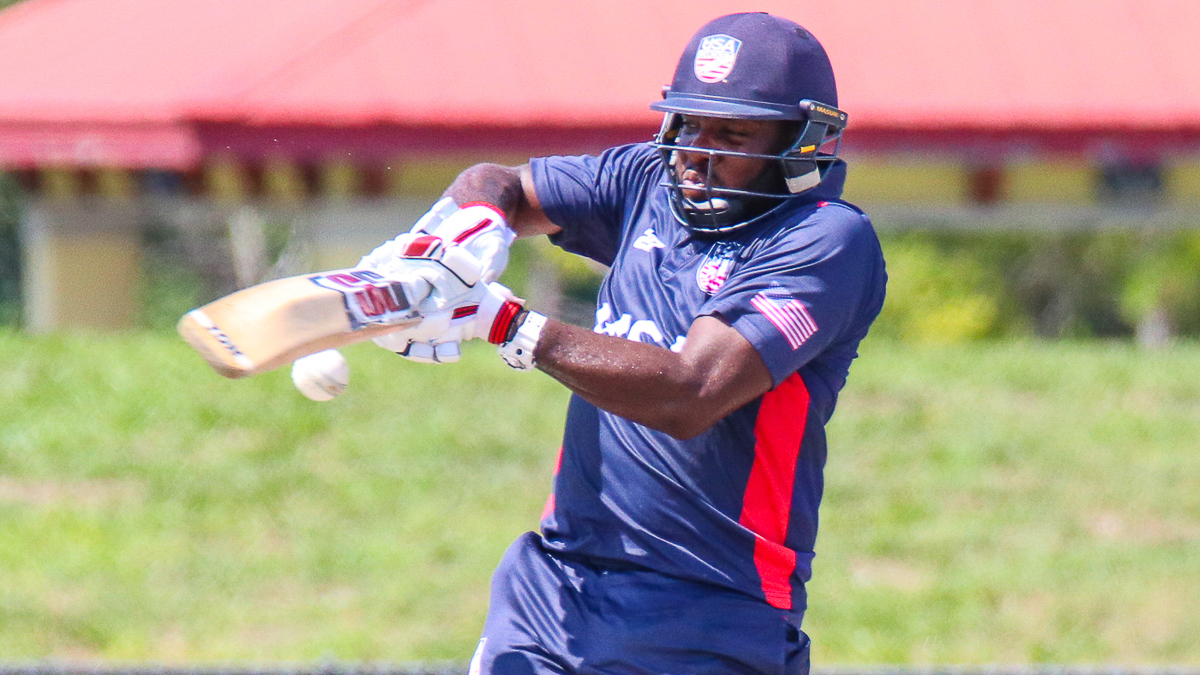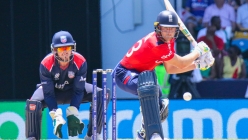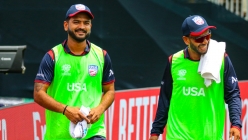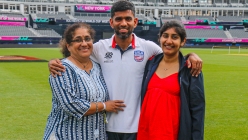Views
USA Cricket: 2021 ODI Tour of Oman Report Card Part 1 – Team Grades
2021 Sep 24 by DreamCricket USA

By Peter Della Penna (Twitter @PeterDellaPenna)DreamCricket reviews the overall team category performances on the 2021 ODI tour of Oman, with grades generally reflecting USA's hit and miss results that ended with a record split down the middle - three wins and three losses.
File photo image credit: Peter Della Penna
Batting: C+
This tour was marked by a lot of Jekyll & Hyde batting. There were some outstanding individual match-winning performances led by Jaskaran Malhotra’s 173 not out against Papua New Guinea and Monank Patel’s 100 against Nepal. Malhotra’s century was USA’s first in 50-over cricket since Xavier Marshall’s 100 off 154 balls against Hong Kong at 2019 WCL Division Two in Namibia, the match that clinched ODI status for USA. It broke a streak of 23 straight matches for USA in List A cricket without a century. Arguably just as impressive if not more so were Steven Taylor’s pair of bruising half-centuries (82 off 55 balls against PNG, 92 off 63 balls against Nepal), both of which set up two of USA’s three wins on tour. In all, USA had five 50-plus scores in six matches.
However, it was almost all or nothing for USA on tour. The next best score for USA in the match where Malhotra made his record-setting knock was 22. If PNG’s fielding hadn’t been so dreadful in dropping Malhotra four times starting on 3, it’s possible that the 22 made by Aaron Jones would have been USA’s top score in that innings. Similarly in the match that USA lost to Nepal where Monak made 100, the next best score was 21. The sharp disparity highlighted USA’s inability to get consistently good partnerships going. USA had five half-century and one century stand across their six matches. All but one – the 66-run ninth-wicket stand between Elmore Hutchinson and Karima Gore in a losing effort to Oman – involved Taylor, Malhotra, or Monank, and three of the six partnerships came against a weak PNG side whereas they could only get three such partnerships total in the four ODIs with points at stake in Cricket World Cup League Two. The all or nothing contributions are also highlighted by the fact that USA had three players on tour cross 200 runs (the same trio), while nobody else managed to get past even 100 runs. The next best came from Karima Gore, with 80 runs in five innings.
USA’s running between the wickets was also quite poor for an international side, once again highlighting the lack of chemistry built up over the years with players unfamiliar with their own roles as well as the batting style of their partner at the other end. One could argue that this could be down to it being USA’s first series back after an 18-month layoff during the Covid pandemic. However, USA’s own ground fielding was vastly superior to every other team in Oman yet only produced one runout. Despite USA’s exceptional fielding prowess, other teams were not making the same foolish errors between the wickets that USA kept on committing despite having an identical layoff between ODIs, in the case of Nepal and Oman, if not longer in the case of PNG. While USA only converted one runout in the field, USA’s batsmen ran themselves out on seven occasions.
The shot selection and mental approach at times also left a lot to be desired. USA has never chased a target higher than 257 in one-day cricket. Yet, they were in a solid position with 20 overs to go in the final match chase against Oman starting at a target of 275, only for some very poor shots to be made resulting in wickets. Oman actually had fewer runs than USA at their corresponding 40-over mark (190 for 4), but scored 85 off their last 10, including four sets of overs with 10+ runs. USA meanwhile never got a chance to seize on any poor death bowling under pressure on this day because they were all out in 39.5 overs, having pressed too hard, too soon when there was so much time left to bat.
The opening role has also yet to be rectified as USA’s revolving door in that position continued. Steven Taylor succeeded (more on that later), but Sushant Modani and Dominique Rikhi did not. The contrast in Taylor’s success vs his partner’s failures is highlighted by the fact that USA’s average Powerplay score of 51 was seven runs better than their opponents, yet USA averaged at least two wickets lost in the Powerplay compared to one for their opponents. On the whole, that extra wicket lost during the Powerplay had a far bigger impact on USA’s overall results than the net seven-run advantage after the first 10 overs. This became further exacerbated by the absence of Aaron Jones for the bulk of the tour through injury. With USA’s best middle-order batsman gone, USA never really got meaningful middle-order contributions during the CWC League Two tri-series portion of the tour.
Bowling: C
USA took 48 out of a possible 60 wickets against their opponents, though only 28 out of 40 against much stronger opposition during the Cricket World Cup League Two tri-series portion of the tour. In some ways, the spread of contributions was very similar to the batting. Another excellent tour for Saurabh Netravalkar where he once again led the team with 12 wickets. Solid work by both Nosthush Kenjige and Nisarg Patel taking 10 and 8 wickets respectively. But there was little support elsewhere.
USA bowlers allowed five half-centuries during the tour, the same number of 50-plus score that USA produced. But USA bowlers allowed eight 50-plus partnerships during the tour, two more than USA had. Crucially, USA allowed seven of those eight partnerships during the CWC League Two matches, when points were at stake.
USA struggled most for new ball breakthroughs. Overall on the tour, USA’s average opposition Powerplay was 44 for 1, having taken seven wickets in the Powerplay in six matches. Again though, this was weighted positively for the PNG contests. USA only took three wickets in the Powerplay in the four CWC League Two matches. On two occasions, USA could not take any wickets in the Powerplay, one each against Nepal and Oman, as the opening stand cruised past 50. Just as USA struggled to bat in partnerships, they also struggled to bowl in partnerships as one bowler’s hard work to build pressure would often times be released at the opposite end.
USA’s death bowling also struggled, particularly against Oman. In the first contest between the two sides, the spinners kept USA in the match as long as possible by drying up runs in the middle overs well into the late stage of the chase. The only boundaries conceded by USA in the last 12 overs of that loss, and two of the only three double-digit overs of the entire chase, came off the bowling of Netravalkar and Hutchinson.
Fielding: B
This may sound like a broken record, but there was some outstanding individual work that lifted up the entire squad spearheaded by Karima Gore. His three-catch performance in the win over Nepal was arguably worth 50-plus runs considering the skill level of his first two catches and the players dismissed on both occasions (Aasif Sheikh & Rohit Paudel) in the context of how they batted in other matches. While USA’s overall catching was of a generally high standard, they faltered at the worst possible time against Oman in the first of the two matches against them, shelling four chances that cost USA 53 incredibly crucial runs in a match that went to the final over. That sequence resulted in a significant marking down of USA’s overall fielding grade for the tour for the impact it had on the match result and the difference between a winning tour vs. a split result tour.
Gore’s ground fielding also set the tone for others to follow and there is an incredibly healthy competition between him and Nosthush Kenjige to see how many times they can one-up each other with something brilliant. Steven Taylor also showed that when he is fit and on the field, he is also an incredible athlete who has incredible lateral fielding quickness and range to deny singles in the ring. Sanjay Krishnamurthi and Dominique Rikhi also deserve mentions for their work along the boundary, whether it was sweeping along the boundary to deny a second run or taking a sharp catch.
According to unofficial stats tracked by this reporter, USA missed nine chances in the field during the tour, which cost USA a total of 99 runs after the first missed chance and an average of 24.75 runs scored before they were eventually dismissed (if they were dismissed). Unsurprisingly, USA ended with a net positive for the tour due to their opponents’ far costlier letoffs. USA gained an extra 468 runs following 17 total missed chances during the tour. USA’s scored their bonus runs at an average of 42.55 after the first missed chance, if the player was ever dismissed.
Fitness: B
The visuals of Taylor throwing up on field after delivering his first over against PNG, before later cramping up early in his time at the crease, and Gajanand Singh collapsing while cramping up after just 17 balls in his debut innings were all far from pretty. Gajanand didn’t play again until the final match, and when he did he was still laboring between the wickets. Nisarg Patel also struggled while cramping up briefly during one of his innings. A case can be made both ways that Taylor missed out on a century against PNG due to his poor fitness entering day one, or that his successful power-hitting during that 82 off 55 balls was an accidental and successful byproduct of his poor fitness because he was reduced to trying to hit boundaries due to an inability to run between the wickets.
Though it was hot in Oman, with temperatures regularly hovering between 95 and 100F, this is nothing too drastically different than what USA’s players have experienced all summer long in home conditions. It’s not as if these fitness issues were cropping up after spending two to three hours at the crease either, which could be justifiable to explain the transition from playing mostly 20-over cricket through the home summer into 50-over cricket. Instead, many of these fitness issues popped up after just five or 10 overs, but always less than 20. Quite simply, a few players entered the tour unfit to play, no matter the format.
On the whole though, the majority of USA’s players demonstrated a high level of fitness. To counter the point about Taylor possibly having missed out on becoming USA’s first ODI centurion due to poor fitness, the centuries scored by both Jaskaran Malhotra and Monank Patel demonstrated their extremely high levels of fitness and commitment to the strength and conditioning program laid out by Burt Cockley. The most impressive part of Malhotra’s six sixes in an over is not how he did it, but when. Most players may have struggled to lift their arms after spending three hours at the crease in the desert heat of Oman, but he was able to muscle the ball over the ropes six straight times in the final over.
Monank was consistently USA’s best batsman on tour and his ability to stay not out in a number of chases again highlighted his fitness being able to sustain his batting after keeping wicket for three and a half hours. This was a drastic improvement for Monank as well, who has routinely struggled with his fitness on previous tours requiring him to spend lengthy periods off the field. Yet saddled with the extra burden of keeping, he took it all in stride.
The fielding fitness of Gore was also a highlight for USA. His boundless energy contributed significantly to keeping pressure on in the field and lift up the spirits of everyone around him. Though their batting contributions were limited, Krishnamurthi and Rikhi’s fielding also highlighted the impact of fitness on USA’s overall fielding.
Tactics: D
One of the most exciting and positive strategic decisions for USA in recent memory was the long overdue decision to move Steven Taylor back to the top as an opener. He has never been someone who rotates the strike well by knocking singles around, but instead has always scored the bulk of his runs in boundaries. Former coach Pubudu Dassanayake essentially tried to fit Taylor’s square peg batting into a round hole by asking him to come in lower and bat longer, and unsurprisingly it rarely had the desired results from 2018-2020. Seeing Taylor back where he belongs was a positive move that benefitted not just Taylor but the entire team.
However, there were a number of not so great strategic moves that backfired or were just plain nonsensical. One match after Malhotra’s 173*, tailender Kenjige was sent in above him at No. 5 to face up to Nepal’s spinners with negligible impact. In most instances, such a historic innings the likes of which Malhotra produced would trigger a promotion up the order. Instead, the opposite happened and it projected an incredibly negative approach from USA, something the Nepal and Oman (and anyone else in CWC League Two) will make a mental note of going forward. Monank had been USA’s best and most consistent batsman throughout the tour, but then was bumped down in the rematch against Nepal so that Gore could come in at No. 3, only for Gore to get out for a duck on an ill-fated charge to Sandeep Lamichhane.
Netravalkar regularly used eight bowling options and in one match even used nine bowlers. A glass half-full view is that he was trying to be as creative as possible to disrupt opposition batsmen. But it looked more often like he was out of ideas and lacked faith in the first-choice options available to make breakthroughs. Captain Netravalkar also had to contend with a short boundary on one side of the ground which impacted certain bowling decisions. But the decision to go with himself and Hutchinson at the death in the first match against Oman – in particular the fatal 49th over bowled by Hutchinson when it was staggeringly obvious that Oman were uncomfortable, afraid or unwilling to take risks against USA’s spinners – proved to be a defining error in the match after USA had battled valiantly to stretch the game to the final over. Leaving Nisarg Patel’s last over to the 50th was also questionable when he was USA’s best spinner on the day – regardless of what the wicket column may say – and had to be bowled out by the 48th or 49th at the latest rather than leaving his final over to the 50th when the game was already decided.
Some of the field settings also proved puzzling. USA made their successful chase against Nepal more difficult than it needed to be as a consequence of free runs and extra chances given away to some peculiar slips positioning which resulted in a half-dozen would-be chances not going to hand. At other times, Netravalkar would produce hyper aggressive field settings – three slips, or a silly point/silly mid-off – only to abandon them in favor of a hyper conservative counter setting at a moment’s notice when the opposition batsmen hadn’t really done anything such as hit a boundary or play in the air over the top of the infield to warrant a change in field.
Kyle Phillip was by far the fastest bowler in the touring squad and offered USA an x-factor as well as variety in what was a very homogeneous attack at times with Netravalkar, Hutchinson and Abhishek Paradkar preferred for the opening CWC League Two ODI as three left-armers who all bowl below 80 mph. But Phillip’s debut was curiously delayed until the penultimate match. Unsurprisingly, his 85-90 mph pace and awkward bounce from his height made Nepal’s batsmen uncomfortable. He ended with three wickets and was a key catalyst in USA’s only win of the tri-series.
There is no blaming Netravalkar though for the batting approach from the 30th over on against Oman in the final match of the tour. USA’s middle-order threw wickets away due to scoreboard pressure that was self-imagined. With an incredible amount of time left in the match and the required run rate still very manageable, the tactical shot selection to throw away several wickets was disappointing to witness and highlighted the absence of Aaron Jones, who excels best in such situations.
USA were always going to be underdogs in the tri-series without vice-captain Jones as well as Ian Holland, who was USA’s leading scorer in their prior tri-series against the same two opponents when USA went winless in February 2020. In one way, clawing out with one win and taking Oman and Nepal deep in two other matches was commendable. But considering the fine margins in which those matches were decided, it’s not unrealistic to believe that the use of better tactics could have seen USA steal at least one more win.
[Views expressed in this article are those of the author, who covered every match as they happened, and do not necessarily represent the views of DreamCricket management. If you have different views or opinions, we respect those views and urge you to provide your feedback, both positive and negative. Feel free to respond to the author via Twitter @PeterDellaPenna.]




